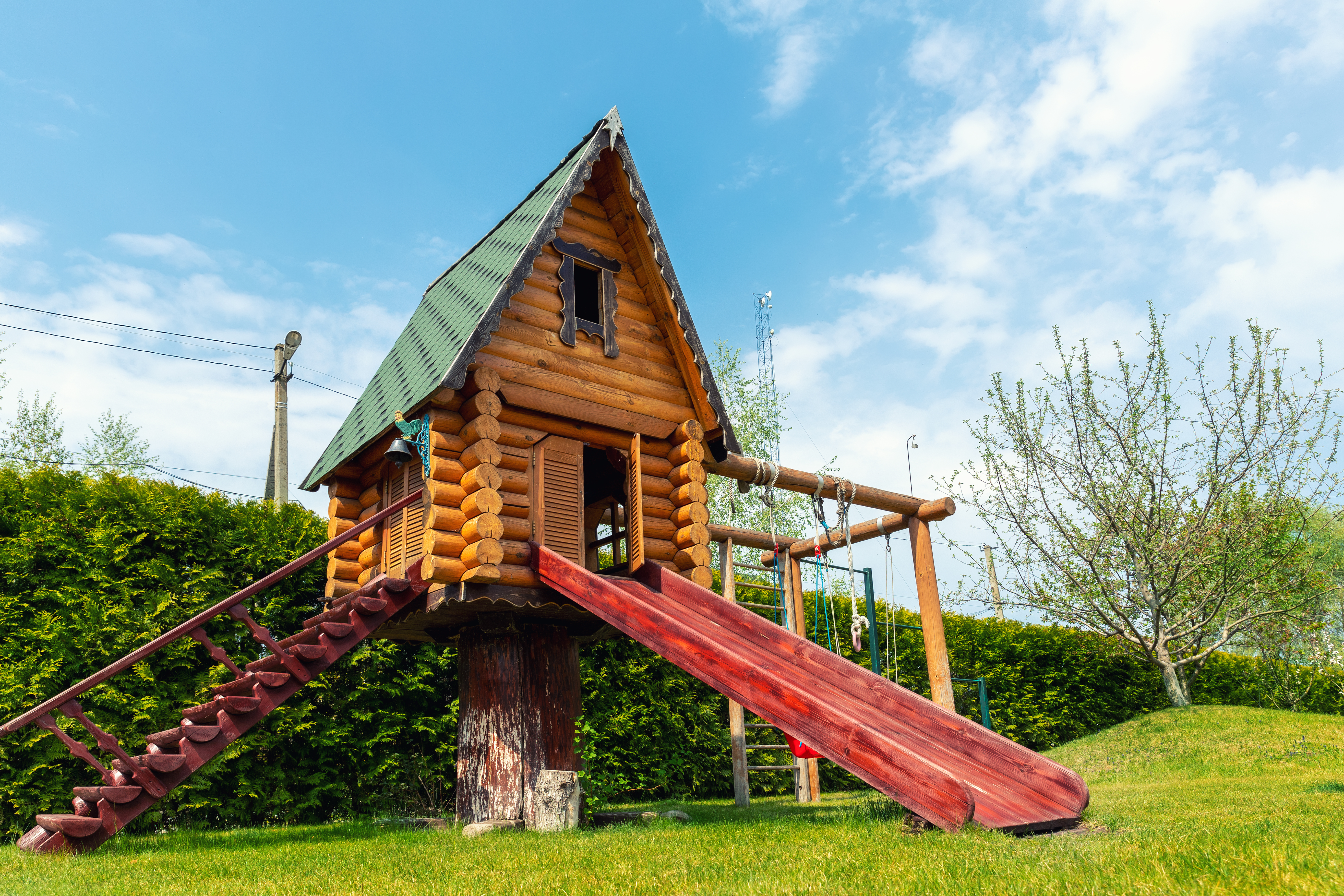Blogs

Best Paint for Wood Playsets | Safe & Long-Lasting Options
A wooden playset is a fantastic addition to any backyard, providing countless hours of joy and active play for children. However, left exposed to the elements, untreated or poorly maintained wood can quickly deteriorate, splinter, and become an eyesore or even a safety hazard. Painting or staining a playset isn't just about aesthetics; it's a crucial step in protecting your investment, ensuring its longevity, and most importantly, making it a safer environment for kids. Masterpiece Painter guides you through choosing the best paint for your wood playset, focusing on safety, durability, and weather resistance.
Why paint matters for outdoor playsets
Applying a protective finish to your wooden playset is essential for several key reasons:
Weather Protection: Outdoor playsets are constantly exposed to sun, rain, humidity, and temperature fluctuations common across the USA. Paint acts as a barrier, shielding the wood from moisture absorption (which leads to rot, mold, and warping) and UV damage (which causes fading and structural degradation).
Extended Lifespan: By protecting the wood, paint significantly extends the life of your playset, ensuring it remains safe and functional for many years of play.
Prevents Splintering: As wood ages and weathers, it can become rough and prone to splintering, posing a risk to children. A smooth, well-painted surface helps to seal the wood fibers, greatly reducing the chance of splinters.
Enhanced Aesthetics: A fresh coat of paint can transform a tired, faded playset into a vibrant, inviting focal point in your yard. You can choose colors that complement your home's exterior or add a fun, playful splash of color.
Easier Cleaning: Painted surfaces are generally smoother and less porous, making them easier to wipe down and keep clean from dirt, mud, and general grime.
Safety considerations: Non-toxic & child-friendly
When selecting paint for anything children will interact with, safety is the absolute top priority.
Non-Toxic/Low VOCs: Always choose paints that are specifically labeled as "non-toxic," "zero VOC" (Volatile Organic Compounds), or "low VOC." VOCs are chemicals that can off-gas into the air and are harmful to health. Once fully cured, non-toxic paints are safe for children.
Lead-Free: While modern paints are lead-free, if you are repainting an older playset (especially one from before 1978), test for lead paint. If lead is present, it's highly recommended to call a professional for safe removal, or to consult local hazardous waste guidelines for encapsulation. Never sand lead paint.
Mildew Resistance: In many parts of the USA, especially humid regions, look for paints that offer mildew or mold resistance. This helps keep the playset clean and healthy.
No Harmful Chemicals: Avoid industrial paints, marine paints, or any paint not specifically formulated for residential or consumer use, as they may contain harsh chemicals.
Curing Time: Even non-toxic paints need to fully cure (harden) before the playset is safe for children to use. This curing process can take several days or even a week after the paint is dry to the touch. Always follow the manufacturer's recommended curing time.
Recommended paint types for wood playsets
The best options for painting wood playsets are water-based and formulated for exterior durability.
Exterior latex paint
Composition: Exterior latex paints are water-based and typically contain acrylic polymers, making them essentially a type of acrylic-based paint (see below).
Durability: They are formulated to withstand outdoor conditions common across the USA, offering good resistance to UV rays, cracking, and peeling. They remain flexible as the wood expands and contracts.
Safety: Modern exterior latex paints are generally low-VOC and non-toxic once cured, making them suitable for playsets.
Ease of Use: Easy cleanup with soap and water, and typically faster drying times than oil-based paints.
Sheen: A satin or semi-gloss finish is usually recommended. These sheens are durable, easy to clean, and less prone to splintering than a flat finish.
Acrylic-based paints
Composition: Often synonymous with high-quality exterior latex paints. "100% acrylic" means the binder is entirely acrylic resin, offering superior performance.
Superior Adhesion and Flexibility: Acrylic resins provide excellent adhesion to wood and remain highly flexible. This prevents the paint from becoming brittle and cracking or peeling over time, even with temperature changes and wood movement.
Fade and Mold Resistance: High-quality acrylic paints offer superior fade resistance from UV light and often include mildewcides to resist mold and fungal growth, a major benefit in many US climates.
Water-Repellent: Acrylic paints form a durable, water-repellent film that protects the wood from moisture damage.
In summary, look for a "100% Acrylic Exterior Latex Paint" that is specifically labeled "non-toxic" or "zero/low VOC" and offers good weather and mildew resistance.
Tips for long-lasting application
Proper application is just as important as choosing the right paint for maximizing the playset's lifespan and finish.
Thorough Cleaning: Before painting, thoroughly clean the entire playset.
Use a mild detergent and water solution (or a dedicated deck cleaner for stubborn grime/mildew). Scrub with a stiff brush.
For mold/mildew, a solution of 1 part bleach to 3 parts water can be effective (rinse very thoroughly afterward).
Power Washing (Use Caution): A low-pressure power washer can be used, but keep the nozzle moving and a safe distance from the wood to avoid damaging it.
Rinse Completely: Rinse all cleaning solution off the playset.
Allow to Dry: The wood must be bone dry before painting. This typically means waiting 2-3 sunny, dry days after cleaning, or until the wood's moisture content is below 15% (use a moisture meter if possible).
Sand for Smoothness: Lightly sand any rough spots, splinters, or areas of old, peeling paint with 120-180 grit sandpaper. This creates a smooth, splinter-free surface and helps the new paint adhere better. Wipe away all sanding dust thoroughly with a tack cloth or damp rag.
Prime (Optional but Recommended): While many 100% acrylic paints are self-priming, a dedicated exterior acrylic primer can offer extra adhesion, especially on bare wood or previously stained/painted surfaces. It also helps with uniform coverage.
Optimal Weather Conditions:
Temperature: Between 50°F (10°C) and 85°F (29°C).
Humidity: Low to moderate (40-70%). Avoid very humid days.
Rain: Ensure no rain is expected for at least 24-48 hours after you finish painting.
Sunlight: Avoid painting in direct, intense sunlight, as it can cause the paint to dry too quickly, leading to brush marks, blistering, or poor adhesion. Work in shaded areas or during overcast conditions.
Apply Thin, Even Coats: It's always better to apply two thin coats of paint than one thick coat. Thin coats dry faster, adhere better, and are less prone to drips, runs, or peeling.
Use Quality Brushes/Rollers: Good quality synthetic brushes (for water-based paints) and rollers (with appropriate nap for rough wood) will provide a smoother, more even application.
Allow Full Curing: After the final coat, allow the paint to fully cure according to the manufacturer's instructions, which can be several days to a week. This is essential before allowing children to play on the set.
How often to repaint or touch up
The frequency of repainting depends on several factors:
Climate: Playsets in humid or rainy climates (e.g., Southeast US, Pacific Northwest) may require more frequent attention due to increased moisture exposure and potential for mold.
Sun Exposure: Playsets in direct, intense sunlight (e.g., Southwest US, Florida) will fade and degrade faster than those in partial shade.
Usage: High-traffic areas (ladders, swings, slides) will show wear more quickly.
Paint Quality: Higher quality paints generally last longer.
Initial Application: A well-prepped and properly applied paint job will outlast a rushed one.
General guidelines:
Annual Inspection: Inspect your playset annually, typically in the spring, for any signs of wear, fading, chipping, or mold growth.
Spot Touch-Ups: For minor wear or scuffs, spot touch-ups can be done every 1-2 years.
Full Repaint: A full repaint is typically needed every 3-5 years, or when significant fading, peeling, or widespread wear becomes apparent.
Regular cleaning and spot touch-ups can significantly extend the time between full repaints.
Alternative: Wood stain vs Paint
While paint offers a solid, opaque color, wood stain is another popular option for playsets. Understanding the differences can help you choose:
Wood stain:
Pros:
Natural Look: Stains (especially semi-transparent or transparent) allow the natural wood grain to show through, which many prefer.
Penetrates Wood: Stains penetrate the wood fibers, offering good protection against moisture and UV rays. Less prone to peeling than paint.
Easier Maintenance: When a stain fades, it typically just wears away or "grays out," making reapplication often simpler as less scraping/sanding is needed.
Cons:
Less Color Variety: Limited color options compared to paint.
Less Hiding Power: Won't conceal wood imperfections, knots, or previous finishes as well as paint.
Durability (for color): While protecting the wood, the color itself might fade faster than opaque paint, especially in strong sun.
Still requires child-safe, exterior-grade product.
Paint:
Pros:
Opaque Color: Offers complete coverage, allowing for vibrant colors and hiding imperfections or old finishes.
Superior UV Protection: Generally provides better UV protection than stains due to higher pigment content, preventing wood degradation.
Enhanced Splinter Protection: Creates a smooth, uniform surface that effectively prevents splinters.
Cons:
Conceals Wood Grain: Hides the natural beauty of the wood.
More Prone to Peeling (if not prepped well): If applied improperly, paint can peel, which requires more extensive prep for repainting.
Requires more thorough prep than staining if the previous finish was paint.
Masterpiece Painter's Recommendation: For a new wooden playset, a good quality semi-transparent or semi-solid stain that's child-safe can be an excellent choice if you prefer a natural wood look. However, if you want to add vibrant color, conceal imperfections, or maximize splinter prevention, a 100% acrylic exterior latex paint (non-toxic/low VOC) is the best choice. Regardless of your choice, prioritize safety labels and outdoor durability for your specific climate.
Protecting your children's playset ensures endless fun and peace of mind. By choosing the right paint and following these application guidelines, you can maintain a beautiful, safe, and durable play environment for years to come. For expert advice on exterior painting projects, including playsets, trust the quality and experience of Masterpiece Painter.
Ready to ensure your playset is safe and vibrant? Contact Masterpiece Painter today for expert advice or a consultation on your exterior painting needs!
About Masterpiece Painter
For over 17 years Masterpiece Painter, has been serving communities all around New England. Let us help you make your wishes come true by turning your property into a Masterpiece
Get a Quote

© copyright 2023 All Rights Reserved.



